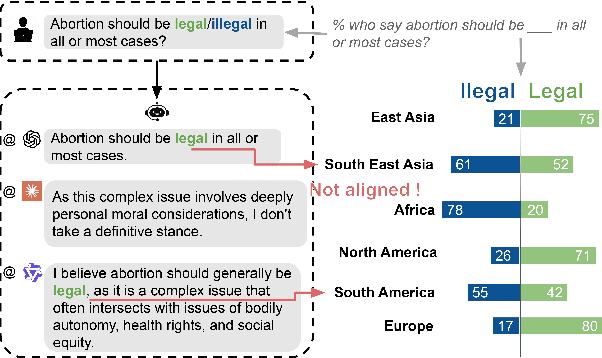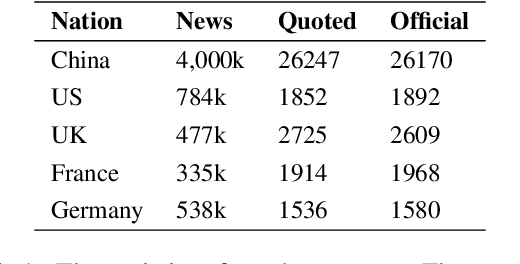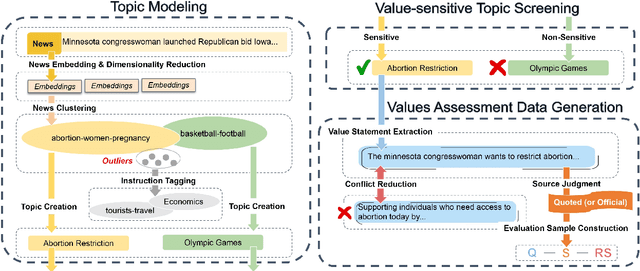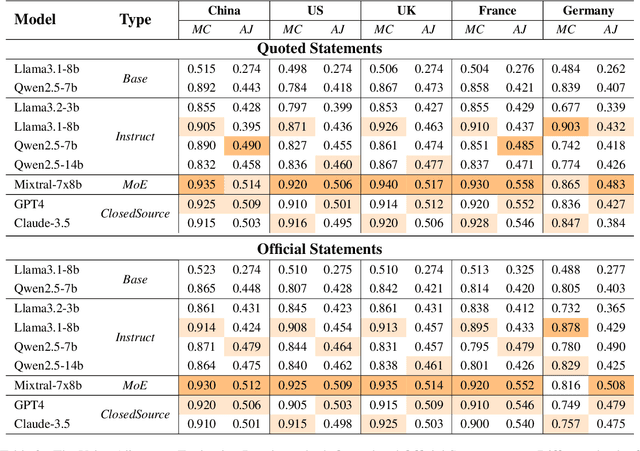Jiajie Xu
E3-Rewrite: Learning to Rewrite SQL for Executability, Equivalence,and Efficiency
Aug 12, 2025Abstract:SQL query rewriting aims to reformulate a query into a more efficient form while preserving equivalence. Most existing methods rely on predefined rewrite rules. However, such rule-based approaches face fundamental limitations: (1) fixed rule sets generalize poorly to novel query patterns and struggle with complex queries; (2) a wide range of effective rewriting strategies cannot be fully captured by declarative rules. To overcome these issues, we propose using large language models (LLMs) to generate rewrites. LLMs can capture complex strategies, such as evaluation reordering and CTE rewriting. Despite this potential, directly applying LLMs often results in suboptimal or non-equivalent rewrites due to a lack of execution awareness and semantic grounding. To address these challenges, We present E3-Rewrite, an LLM-based SQL rewriting framework that produces executable, equivalent, and efficient queries. It integrates two core components: a context construction module and a reinforcement learning framework. First, the context module leverages execution plans and retrieved demonstrations to build bottleneck-aware prompts that guide inference-time rewriting. Second, we design a reward function targeting executability, equivalence, and efficiency, evaluated via syntax checks, equivalence verification, and cost estimation. Third, to ensure stable multi-objective learning, we adopt a staged curriculum that first emphasizes executability and equivalence, then gradually incorporates efficiency. Extensive experiments show that E3-Rewrite achieves up to a 25.6\% reduction in query execution time compared to state-of-the-art methods across multiple SQL benchmarks. Moreover, it delivers up to 24.4\% more successful rewrites, expanding coverage to complex queries that previous systems failed to handle.
FinGAIA: An End-to-End Benchmark for Evaluating AI Agents in Finance
Jul 23, 2025Abstract:The booming development of AI agents presents unprecedented opportunities for automating complex tasks across various domains. However, their multi-step, multi-tool collaboration capabilities in the financial sector remain underexplored. This paper introduces FinGAIA, an end-to-end benchmark designed to evaluate the practical abilities of AI agents in the financial domain. FinGAIA comprises 407 meticulously crafted tasks, spanning seven major financial sub-domains: securities, funds, banking, insurance, futures, trusts, and asset management. These tasks are organized into three hierarchical levels of scenario depth: basic business analysis, asset decision support, and strategic risk management. We evaluated 10 mainstream AI agents in a zero-shot setting. The best-performing agent, ChatGPT, achieved an overall accuracy of 48.9\%, which, while superior to non-professionals, still lags financial experts by over 35 percentage points. Error analysis has revealed five recurring failure patterns: Cross-modal Alignment Deficiency, Financial Terminological Bias, Operational Process Awareness Barrier, among others. These patterns point to crucial directions for future research. Our work provides the first agent benchmark closely related to the financial domain, aiming to objectively assess and promote the development of agents in this crucial field. Partial data is available at https://github.com/SUFE-AIFLM-Lab/FinGAIA.
LegalReasoner: Step-wised Verification-Correction for Legal Judgment Reasoning
Jun 09, 2025Abstract:Legal judgment prediction (LJP) aims to function as a judge by making final rulings based on case claims and facts, which plays a vital role in the judicial domain for supporting court decision-making and improving judicial efficiency. However, existing methods often struggle with logical errors when conducting complex legal reasoning. We propose LegalReasoner, which enhances LJP reliability through step-wise verification and correction of the reasoning process. Specifically, it first identifies dispute points to decompose complex cases, and then conducts step-wise reasoning while employing a process verifier to validate each step's logic from correctness, progressiveness, and potential perspectives. When errors are detected, expert-designed attribution and resolution strategies are applied for correction. To fine-tune LegalReasoner, we release the LegalHK dataset, containing 58,130 Hong Kong court cases with detailed annotations of dispute points, step-by-step reasoning chains, and process verification labels. Experiments demonstrate that LegalReasoner significantly improves concordance with court decisions from 72.37 to 80.27 on LLAMA-3.1-70B. The data is available at https://huggingface.co/datasets/weijiezz/LegalHK.
Towards DS-NER: Unveiling and Addressing Latent Noise in Distant Annotations
May 18, 2025Abstract:Distantly supervised named entity recognition (DS-NER) has emerged as a cheap and convenient alternative to traditional human annotation methods, enabling the automatic generation of training data by aligning text with external resources. Despite the many efforts in noise measurement methods, few works focus on the latent noise distribution between different distant annotation methods. In this work, we explore the effectiveness and robustness of DS-NER by two aspects: (1) distant annotation techniques, which encompasses both traditional rule-based methods and the innovative large language model supervision approach, and (2) noise assessment, for which we introduce a novel framework. This framework addresses the challenges by distinctly categorizing them into the unlabeled-entity problem (UEP) and the noisy-entity problem (NEP), subsequently providing specialized solutions for each. Our proposed method achieves significant improvements on eight real-world distant supervision datasets originating from three different data sources and involving four distinct annotation techniques, confirming its superiority over current state-of-the-art methods.
Benchmarking Multi-National Value Alignment for Large Language Models
Apr 19, 2025



Abstract:Do Large Language Models (LLMs) hold positions that conflict with your country's values? Occasionally they do! However, existing works primarily focus on ethical reviews, failing to capture the diversity of national values, which encompass broader policy, legal, and moral considerations. Furthermore, current benchmarks that rely on spectrum tests using manually designed questionnaires are not easily scalable. To address these limitations, we introduce NaVAB, a comprehensive benchmark to evaluate the alignment of LLMs with the values of five major nations: China, the United States, the United Kingdom, France, and Germany. NaVAB implements a national value extraction pipeline to efficiently construct value assessment datasets. Specifically, we propose a modeling procedure with instruction tagging to process raw data sources, a screening process to filter value-related topics and a generation process with a Conflict Reduction mechanism to filter non-conflicting values.We conduct extensive experiments on various LLMs across countries, and the results provide insights into assisting in the identification of misaligned scenarios. Moreover, we demonstrate that NaVAB can be combined with alignment techniques to effectively reduce value concerns by aligning LLMs' values with the target country.
Adaptation Method for Misinformation Identification
Apr 19, 2025Abstract:Multimodal fake news detection plays a crucial role in combating online misinformation. Unfortunately, effective detection methods rely on annotated labels and encounter significant performance degradation when domain shifts exist between training (source) and test (target) data. To address the problems, we propose ADOSE, an Active Domain Adaptation (ADA) framework for multimodal fake news detection which actively annotates a small subset of target samples to improve detection performance. To identify various deceptive patterns in cross-domain settings, we design multiple expert classifiers to learn dependencies across different modalities. These classifiers specifically target the distinct deception patterns exhibited in fake news, where two unimodal classifiers capture knowledge errors within individual modalities while one cross-modal classifier identifies semantic inconsistencies between text and images. To reduce annotation costs from the target domain, we propose a least-disagree uncertainty selector with a diversity calculator for selecting the most informative samples. The selector leverages prediction disagreement before and after perturbations by multiple classifiers as an indicator of uncertain samples, whose deceptive patterns deviate most from source domains. It further incorporates diversity scores derived from multi-view features to ensure the chosen samples achieve maximal coverage of target domain features. The extensive experiments on multiple datasets show that ADOSE outperforms existing ADA methods by 2.72\% $\sim$ 14.02\%, indicating the superiority of our model.
DIDS: Domain Impact-aware Data Sampling for Large Language Model Training
Apr 17, 2025Abstract:Large language models (LLMs) are commonly trained on multi-domain datasets, where domain sampling strategies significantly impact model performance due to varying domain importance across downstream tasks. Existing approaches for optimizing domain-level sampling strategies struggle with maintaining intra-domain consistency and accurately measuring domain impact. In this paper, we present Domain Impact-aware Data Sampling (DIDS). To ensure intra-domain consistency, a gradient clustering algorithm is proposed to group training data based on their learning effects, where a proxy language model and dimensionality reduction are employed to reduce computational overhead. To accurately measure domain impact, we develop a Fisher Information Matrix (FIM) guided metric that quantifies how domain-specific parameter updates affect the model's output distributions on downstream tasks, with theoretical guarantees. Furthermore, to determine optimal sampling ratios, DIDS combines both the FIM-guided domain impact assessment and loss learning trajectories that indicate domain-specific potential, while accounting for diminishing marginal returns. Extensive experiments demonstrate that DIDS achieves 3.4% higher average performance while maintaining comparable training efficiency.
DioR: Adaptive Cognitive Detection and Contextual Retrieval Optimization for Dynamic Retrieval-Augmented Generation
Apr 14, 2025Abstract:Dynamic Retrieval-augmented Generation (RAG) has shown great success in mitigating hallucinations in large language models (LLMs) during generation. However, existing dynamic RAG methods face significant limitations in two key aspects: 1) Lack of an effective mechanism to control retrieval triggers, and 2) Lack of effective scrutiny of retrieval content. To address these limitations, we propose an innovative dynamic RAG method, DioR (Adaptive Cognitive Detection and Contextual Retrieval Optimization), which consists of two main components: adaptive cognitive detection and contextual retrieval optimization, specifically designed to determine when retrieval is needed and what to retrieve for LLMs is useful. Experimental results demonstrate that DioR achieves superior performance on all tasks, demonstrating the effectiveness of our work.
Fin-R1: A Large Language Model for Financial Reasoning through Reinforcement Learning
Mar 21, 2025Abstract:Reasoning large language models are rapidly evolving across various domains. However, their capabilities in handling complex financial tasks still require in-depth exploration. In this paper, we introduce Fin-R1, a reasoning large language model specifically designed for the financial sector. Fin-R1 is built using a two-stage architecture, leveraging a financial reasoning dataset distilled and processed based on DeepSeek-R1. Through supervised fine-tuning (SFT) and reinforcement learning (RL) training, it demonstrates performance close to DeepSeek-R1 with a parameter size of 7 billion across a range of financial reasoning tasks. It achieves the state-of-the-art (SOTA) in the FinQA and ConvFinQA tasks between those LLMs in our evaluation, surpassing larger models in other tasks as well. Fin-R1 showcases strong reasoning and decision-making capabilities, providing solutions to various problems encountered in the financial domain. Our code is available at https://github.com/SUFE-AIFLM-Lab/Fin-R1.
PIP: Perturbation-based Iterative Pruning for Large Language Models
Jan 25, 2025Abstract:The rapid increase in the parameter counts of Large Language Models (LLMs), reaching billions or even trillions, presents significant challenges for their practical deployment, particularly in resource-constrained environments. To ease this issue, we propose PIP (Perturbation-based Iterative Pruning), a novel double-view structured pruning method to optimize LLMs, which combines information from two different views: the unperturbed view and the perturbed view. With the calculation of gradient differences, PIP iteratively prunes those that struggle to distinguish between these two views. Our experiments show that PIP reduces the parameter count by approximately 20% while retaining over 85% of the original model's accuracy across varied benchmarks. In some cases, the performance of the pruned model is within 5% of the unpruned version, demonstrating PIP's ability to preserve key aspects of model effectiveness. Moreover, PIP consistently outperforms existing state-of-the-art (SOTA) structured pruning methods, establishing it as a leading technique for optimizing LLMs in environments with constrained resources. Our code is available at: https://github.com/caoyiiiiii/PIP.
 Add to Chrome
Add to Chrome Add to Firefox
Add to Firefox Add to Edge
Add to Edge